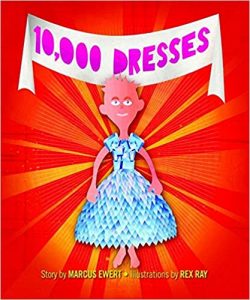Gender Identity & Gender Roles
10,000 dresses

Author(s): Marcus Ewert & Rex Ray
Links:
Amazon: https://amzn.to/2FnYZxx
Indigo: https://bit.ly/2JM34zS
Social Justice focus: Gender roles/ Women’s rights
Synopsis: This picture book is a modern-day fairy tale that explores the possibility of becoming the person you feel you are on the inside. Dreams are not bound by gender roles. Everybody has their own imagination and outlook towards life. The story of Bailey, a boy who is fascinated by dreams about magical dresses every night. Even his parents do not acknowledge his passion. However, he does realize his dreams as he finds a companion Laurel and the two work together to make dresses.
Lesson Plan: Emily Todd
Primary/Junior/Intermediate Lesson Plan (Abbreviated Template)
Consecutive and Concurrent Programs
Unit/Topic: Social Justice Topics in Picture Book
Grade: 8
Lesson: Breaking Down Gender Stereotypes with “10,000 Dresses”
Curriculum Expectations:
Language Arts
- Oral Communication- Listening to Understand, Making Inferences/ Interpreting Texts 1.5: develop and explain interpretations of oral texts using the language of the text and oral and visual cues to support their interpretations
- Media Literacy- Producing Media Texts 3.4: produce a variety of media texts of some technical complexity for specific purposes and audiences, using appropriate forms, conventions, and techniques.
Health and Physical Education
- Healthy Living- Human Development and Sexual Health D1.5: demonstrate an understanding of gender identity (e.g., male, female, Two-Spirit, transgender), gender expression, and sexual orientation (e.g., heterosexual, gay, lesbian, bisexual, pansexual, asexual), and identify factors that can help individuals of all identities and orientations develop a positive self-concept.
Learning Goal(s):
- Understand the importance of freedom of gender expression and identity.
- Keep an open mind during class discussions to learn about and accept new opinions.
- Listen to an oral text to make interpretations and draw conclusions about the characters’ development.
Success Criteria:
- Represent my understanding of gender identity using a visual poster.
- I can use the text to promote equity and eliminate gender stereotypes, using the poster.
- I can contribute to the class discussion (Ladder of Inference).
- I can work independently to create my poster.
______________________________________________________________________________
MODIFICATIONS / ACCOMMODATIONS:
- Students can be given a list of vocabulary associated with the lesson (i.e., gender, identity, expression).
- Students can present their media poster in a variety of ways: drawn poster, Google Doc or Slides, Book Creator, website, video, etc.
- Students can be given a checklist of what is expected for the task.
- Students can have a conversation with the teacher about their understanding of gender identity and expression, instead of writing an exit ticket.
________________________________________________________________
MINDS- ON: 20 minutes
Task:
- Teacher will read the book, “10,000 Dresses,” aloud to students.
- Students can sketch note during the reading, drawing images of what the text means to them, writing down key terms and ideas.
- Ladder of Inference: students come together in a circle to discuss the following questions, using the “Ladder of Inference” framework.
- Guiding questions:
- What do you see, describe the main character? The mother and father?
- What assumptions can we make about their appearance? How does this relate to their character development in the story (consider their relationships to other characters, their own self-identity and self- expression).
- What real-world connections can we make?
- Guiding questions:
Assessment:
- Anecdotal notes: the teacher can record which students are participating in the discussion.
- Checklist (Y/N): the teacher can collect the students’ sketch notes to determine who was listening to the reading, what ideas they formed, etc.
________________________________________________________________
ACTION: 30 minutes
Task:
- The teacher will show the following video to students, and ask them to make connections between what they see, and themes in the book:
- The teacher will show students examples of gender equity posters from the CCGSD website, as students will be creating their own:
- http://ccgsd-ccdgs.org/gender-elephant/
- Using the book and video as inspiration, students will create a poster promoting gender equity and the freedom to express gender.
Assessment: Rating scale- using the success criteria, students will be assessed using a + or – to determine if they met or exceeded the criteria.
CONSOLIDATION: 5 minutes
Task: Students will complete an exit card to reflect on the class activity. They will answer the question: “why do you think it is important for individuals to have the freedom to express their gender identity?”
Assessment: Students will be given feedback on their answer, based on their ability to answer the question, make connections to the text(s), and real-world connections.
________________________________________________________________
MATERIALS:
- Cue cards
- Ladder of Inference Framework: https://methods.sagepub.com/reference/encyclopedia-of-action-research/n191.xml
- Poster paper, pencil crayons, markers
- Book, “10,000 Dresses”
- CCGSD sample gender equity poster
- Video: Boys and girls can do anything
- Chromebooks
REFLECTION: Questions to determine the success of your lesson:
- Were my students successful in meeting the learning goals and success criteria? How do I know?
- Did my instructional decisions meet the needs of all students? If not, what are my next steps?
- What worked well and why?
- What will I do differently in the future when teaching this lesson? For the subsequent lesson?
- What are the next steps for my professional learning?

